1. If two forces of 5 N each are acting along X and Y axes, then the magnitude and direction of resultant is
a) \[5\sqrt{2},\pi\diagup3\]
b) \[5\sqrt{2},\pi\diagup4\]
c) \[-5\sqrt{2},\pi\diagup3\]
d) \[-5\sqrt{2},\pi\diagup4\]
Explanation:
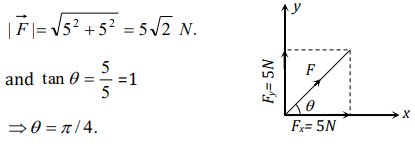
2. Which of the following is the correct order of forces
a) Weak < gravitational forces < strong forces(nuclear) < electrostatic
b) Gravitational < weak < (electrostatic) < strong force
c) Gravitational < electrostatic < weak < strong force
d) Weak < gravitational < electrostatic < strong forces
Explanation: Gravitational < weak < (electrostatic) < strong force
3. A block is kept on a frictionless inclined surface with angle of inclination \['\alpha'\]. The incline is given an acceleration 'a' to keep the block stationary.
Then a is equal to

a) g
b) g\[ tan\alpha\]
c) g\[\diagup tan\alpha\]
d) g\[ cosec \alpha\]
Explanation:
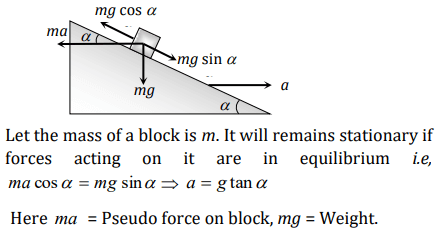
4. A block of mass M is pulled along a horizontal frictionless surface by a rope of mass m. If a force P is applied at the free end of the rope, the force
exerted by the rope on the block will be
a) P
b) \[\frac{Pm}{M+m}\]
c) \[\frac{PM}{M+m}\]
d) \[\frac{Pm}{M-m}\]
Explanation:
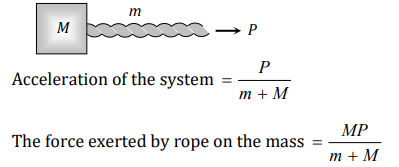
5. A rope of length L is pulled by a constant force F. What is the tension in the rope at a distance x from the end where the force is applied
a) \[\frac{FL}{x}\]
b) \[\frac{F\left(L-x\right)}{L}\]
c) \[\frac{FL}{L-x}\]
d) \[\frac{Fx}{L-x}\]
Explanation: \[\frac{F\left(L-x\right)}{L}\]
6. Three equal weights A, B and C of mass 2 kg each are hanging on a string passing over a fixed frictionless pulley as shown in the figure The tension in the string connecting weights B and C
is

a) Zero
b) 13 N
c) 3.3 N
d) 19.6 N
Explanation:
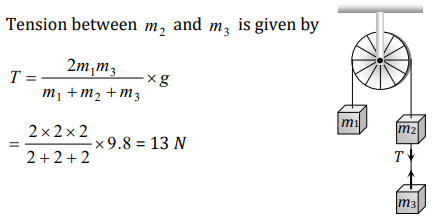
7. Two masses 2 kg and 3 kg are attached to the end of the string passed over a pulley fixed at the top. The tension and acceleration are
a) \[\frac{7g}{8};\frac{g}{8}\]
b) \[\frac{21g}{8};\frac{g}{8}\]
c) \[\frac{21g}{8};\frac{g}{5}\]
d) \[\frac{12g}{5};\frac{g}{5}\]
Explanation:
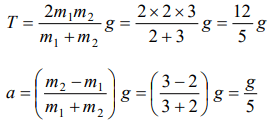
8. Three blocks A, B and C weighing 1, 8 and 27 kg respectively are connected as shown in the figurewith an inextensible string and are moving on a smooth surface. \[T_{3}\] is equal to 36 N. Then \[T_{2}\] is

a) 18 N
b) 9 N
c) 3.375 N
d) 1.25 N
Explanation:
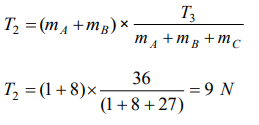
9. Two bodies of mass 3 kg and 4 kg are suspended at the ends of massless string passing over a frictionless pulley. The acceleration of the system is \[\left(g=9.8m\diagup s^{2}\right)\]
a) \[4.9m\diagup s^{2}\]
b) \[2.45m\diagup s^{2}\]
c) \[1.4m\diagup s^{2}\]
d) \[9.5m\diagup s^{2}\]
Explanation:
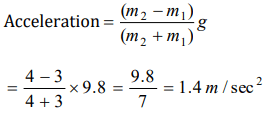
10. Three solids of masses \[m_{1},m_{2}\] and \[m_{3}\] are connected with weightless string in succession and are placed on a frictionless table. If the mass
\[ m_{3}\] is dragged with a force T, the tension in the string between \[m_{2}\] and \[m_{3}\] is
a) \[\frac{m_{2}}{m_{1}+m_{2} +m_{3}}T\]
b) \[\frac{m_{3}}{m_{1}+m_{2} +m_{3}}T\]
c) \[\frac{m_{1}+m_{2}}{m_{1}+m_{2} +m_{3}}T\]
d) \[\frac{m_{2}+m_{3}}{m_{1}+m_{2} +m_{3}}T\]
Explanation:
